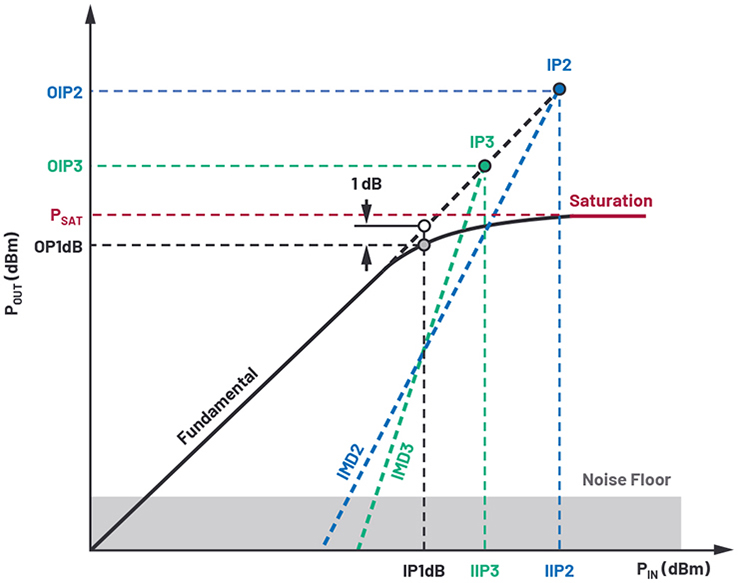
A guide for choosing the right RF amplifier for your application
Question: How do I choose the right RF amplifier and what are their differences?
Anton Patyuchenko, Field Applications Engineer
Answer: Consider features such as the gain, noise, bandwidth, and efficiency to select the right RF amplifier for the right application.
This article will review the most used RF amplifiers. It will describe how gain, noise, bandwidth, efficiency, and various functional features affect amplifier selection for different applications.
RF amplifiers come in a variety of types and forms designed to address different application scenarios. However, the broad diversity of RF amplifier designs existing today does not always make it easier to select the right device for the target application. While the key characteristic of virtually every RF amplifier is its gain, this is not the only and often not even the most important parameter to consider to make the right choice.
The gain shows how much boost an RF amplifier can provide to a signal represented by the ratio of the output power to the input power in dB. It is normally specified for the linear mode of an amplifier where the change in output power is linear with respect to a corresponding change in input power (see Figure 1). If we continue increasing the power level of an input signal passing through an RF amplifier, the device will start transitioning into a nonlinear mode and generate spurious frequency components. These undesired components, which include harmonics and intermodulation products (see H2, H3, IMD2, and IMD3 in Figure 2), represent the intermodulation distortion (IMD) seen at the output of the RF amplifier. The ability of an RF amplifier to handle different input power levels without introducing significant distortions describes its linearity performance, which can be expressed in terms of different parameters (see Figure 1), including:
- The output 1 dB compression point (OP1dB), which defines the output power level at which the gain of a system decreases by 1 dB.
- The saturated output power (PSAT), which is the power level achieved when a change in an input power does not change the output power level.
- The second-order intercept point (IP2) and third-order intercept point (IP3), which are hypothetical points for the input (IIP2, IIP3) and output (OIP2, OIP3) signal power levels at which the power of the corresponding spurious components would reach the same level of fundamental components.
 |  |
Although the gain describes the key functional purpose of the RF amplifier, linearity characteristics and other features play a critical role in determining the RF amplifier selection. In fact, the type of RF amplifier selected always involves a trade-off between different design parameters. The following sections present a short guide to choosing the right type of an RF amplifier for the target use case.
Low Noise Amplifiers
Low noise amplifiers (LNAs) are often used in receiver applications to amplify weak signals right at the front end of a signal chain interfacing an antenna. This type of RF amplifier is optimized to fulfill this function by introducing minimum noise to the signal. Minimization of noise is especially important at the front stages of the signal chain since these stages contribute the most to the overall noise figure of the complete system.
Low Phase Noise Amplifiers
Low phase noise amplifiers offer minimum additive phase noise, which makes them an ideal choice for RF signal chains requiring high signal integrity. Phase noise is a close-in noise to the carrier, which appears as jitter characterized by small fluctuations in the phase of a signal in the time domain. Therefore, low phase noise amplifiers are ideal for combining with high performance PLL synthesizers in high speed clock and LO networks.
Power Amplifiers
Power amplifiers (PAs) are optimized for power handling performance and they are used in applications, such as transmitter systems, designed to deliver high power levels. These amplifiers are usually characterized by high OP1dB or PSAT and offer high efficiency, which allows maintaining low heat dissipation.
High Linearity Amplifiers
High linearity amplifiers are designed to offer a high third-order intercept point with a minimum level of spurs over a wide range of input powers. This type of device is a common choice for communication applications using complex modulated signals that require an RF amplifier capable of handling high crest factors with minimum signal distortions to maintain low bit error rates.
Variable Gain Amplifiers
Variable gain amplifiers (VGAs) are used in applications that need to accommodate signal level variations with flexible gain regulation. VGAs provide this function by offering an adjustable gain that can be changed either digitally in steps by using digitally controlled VGAs or continuously by using analog controlled VGAs. This type of amplifier is often used for automatic gain control (AGC) and for gain drift compensation due to variations in temperature or the characteristics of other components.
Wideband Amplifiers
Multifaceted broadband applications will benefit from the wideband amplifiers designed to deliver moderate gain over a broad range of frequencies often spanning up to several octaves. These amplifiers offer a large gain bandwidth product that usually comes at the cost of mediocre efficiency and noise.
Gain Blocks
Other general-purpose RF applications can also rely on gain blocks representing a broad category of RF amplifiers that can cover various frequencies, bandwidths, gains, and output power levels. These amplifiers usually offer a flat gain response and a good return loss. Their designs often include matching and biasing circuits, making their integration into a signal chain easier since they require a minimum number of external components.
Conclusion
This article has given a few examples of RF amplifiers and their applications. However, the broad diversity of these devices and the numerous use cases they have been designed for go beyond this short article. RF amplifiers can be designed using different assembly and process technologies to offer various integrated features, support specific operational modes, and deliver optimized performance characteristics that address various applications ranging from communication and industrial systems, all the way up to test and measurement equipment and aerospace systems.
About the Author: Anton Patyuchenko received his Master of Science in microwave engineering from the Technical University of Munich in 2007. Following his graduation, Anton worked as a scientist at German Aerospace Center (DLR). He joined © Analog Devices as a field applications engineer in 2015 and is currently providing field applications support to strategic and key customers of Analog Devices specialising in RF applications.
